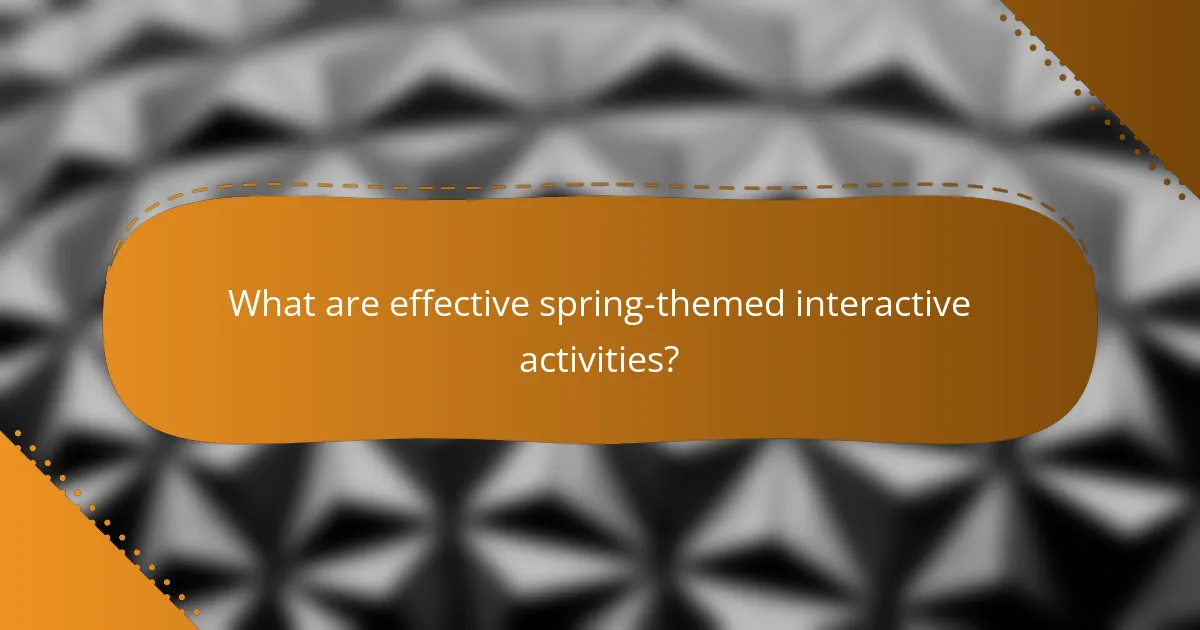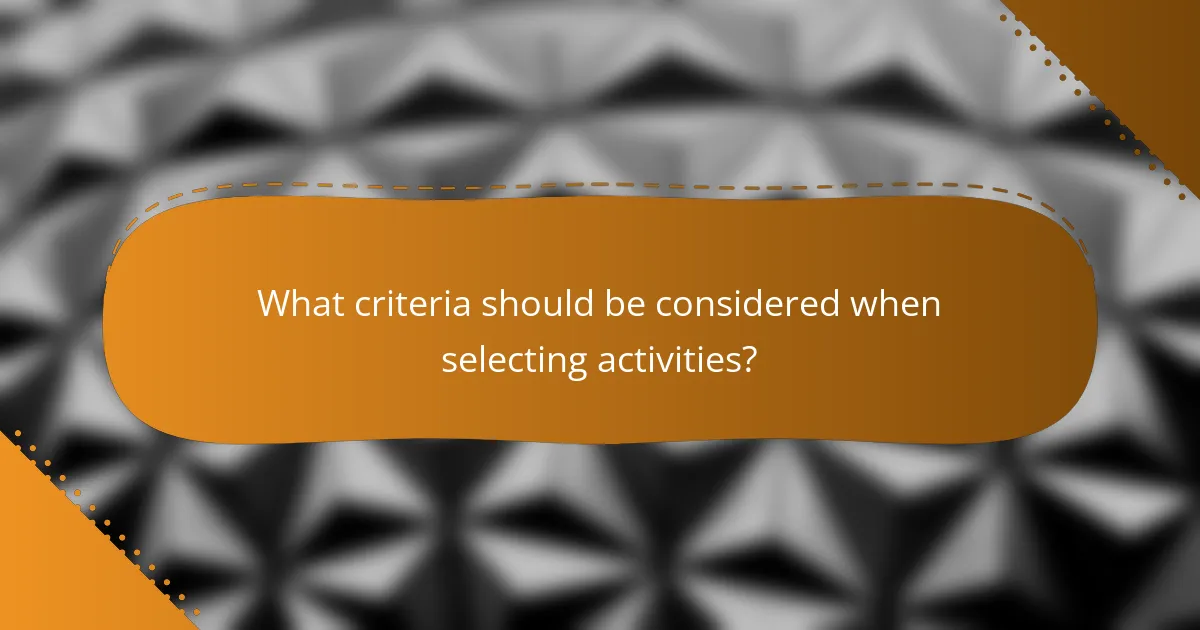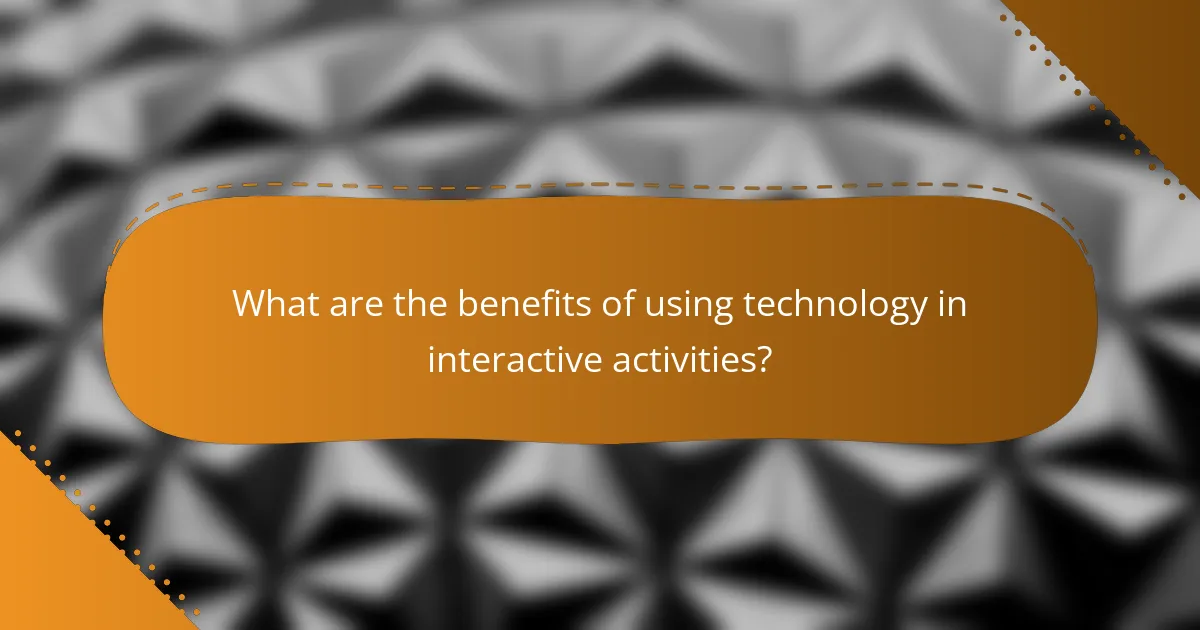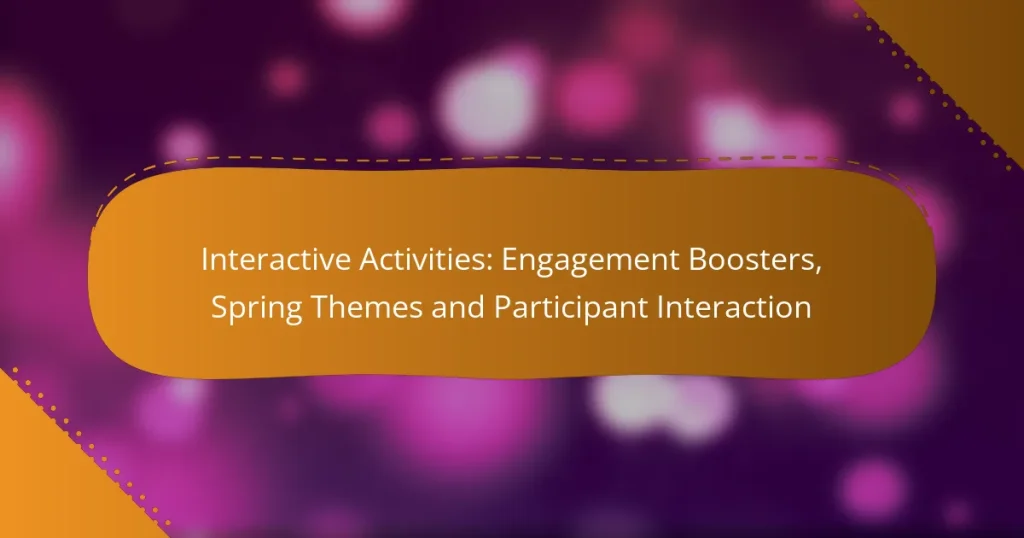Interactive activities play a crucial role in enhancing participant engagement during spring events by promoting collaboration and creating lasting memories. By incorporating hands-on experiences that celebrate the season, these activities not only foster community connections but also enrich the overall enjoyment and learning related to spring themes.

How can interactive activities enhance engagement in spring events?
Interactive activities significantly boost participant engagement in spring events by fostering collaboration and creating memorable experiences. These activities encourage attendees to connect with each other and the event content, making the overall experience more enjoyable and impactful.
Interactive workshops
Interactive workshops allow participants to actively engage with the material through hands-on activities and discussions. These sessions can cover a variety of topics, from gardening techniques to creative writing, tailored to the spring theme. Consider limiting group sizes to enhance participation and ensure everyone has a chance to contribute.
To maximize effectiveness, incorporate tools like breakout sessions or brainstorming activities. This approach not only keeps attendees involved but also encourages networking and idea sharing.
Team-building games
Team-building games are excellent for fostering camaraderie and collaboration among participants. Activities such as relay races or problem-solving challenges can be designed around spring themes, like nature scavenger hunts or flower arranging competitions. These games should be inclusive, catering to various skill levels to ensure everyone can participate.
When organizing team-building games, set clear objectives and provide necessary materials in advance. This preparation helps participants focus on teamwork and enjoyment rather than logistics.
Live polls and quizzes
Live polls and quizzes are effective tools for engaging attendees in real-time during events. These interactive elements can be used to gather opinions or test knowledge on spring-related topics, such as environmental awareness or local flora. Utilize mobile apps or audience response systems to facilitate participation and keep the atmosphere lively.
To enhance engagement, consider offering small prizes for quiz winners. This adds a competitive edge and encourages more participants to join in.
Outdoor scavenger hunts
Outdoor scavenger hunts are a fun way to encourage exploration and teamwork in a spring setting. Participants can search for items related to the season, such as specific flowers or wildlife, promoting physical activity and interaction with nature. Ensure the hunt is well-organized with clear instructions and time limits to maintain excitement.
Incorporate local landmarks or community features into the scavenger hunt to deepen participants’ connection to the area. This not only enhances the experience but also supports local engagement.
Creative art stations
Creative art stations provide a hands-on opportunity for participants to express themselves while engaging with the spring theme. Set up areas for activities like painting, crafting, or flower arranging, allowing attendees to create personal keepsakes. Ensure materials are readily available and accessible to all skill levels.
To encourage participation, consider offering guided sessions or tutorials. This can help those who may feel intimidated by art activities to join in and enjoy the creative process.

What are effective spring-themed interactive activities?
Effective spring-themed interactive activities engage participants through hands-on experiences that celebrate the season. These activities can foster community connections while promoting learning and enjoyment of springtime themes.
Spring-themed trivia contests
Spring-themed trivia contests are engaging ways to test knowledge about the season, including topics like flowers, holidays, and local wildlife. Participants can compete individually or in teams, making it a fun social event.
To organize a trivia contest, prepare a mix of easy and challenging questions. Consider using a platform that allows for real-time responses, or host it in person with printed sheets. Offering small prizes can enhance motivation and participation.
Gardening workshops
Gardening workshops provide hands-on learning experiences about planting and caring for spring flowers and vegetables. These sessions can cater to various skill levels, from beginners to seasoned gardeners.
When planning a workshop, consider including practical demonstrations, such as seed planting or soil preparation. Participants can take home their planted seeds or seedlings, reinforcing the learning experience. Local gardening experts can be invited to share tips specific to the region’s climate.
Nature walks with interactive elements
Nature walks with interactive elements encourage participants to explore local flora and fauna while engaging in activities like scavenger hunts or guided discussions. These walks can be tailored to different age groups and interests.
To enhance the experience, provide participants with checklists of plants or animals to spot during the walk. Incorporating educational stops where guides share interesting facts can deepen participants’ appreciation for nature. Ensure the route is accessible and safe for all participants.
Seasonal cooking classes
Seasonal cooking classes focus on using fresh, spring ingredients to create delicious dishes. These classes can highlight local produce and teach participants about seasonal eating benefits.
When organizing a cooking class, select recipes that are simple yet flavorful, such as salads featuring spring greens or dishes using herbs. Consider offering a tasting session at the end to allow participants to enjoy their creations. Collaborating with local chefs can add expertise and excitement to the class.

How to encourage participant interaction during activities?
Encouraging participant interaction during activities is essential for enhancing engagement and fostering a collaborative environment. Implementing strategies that promote communication and feedback can significantly boost involvement and satisfaction among participants.
Utilizing social media for engagement
Social media platforms can serve as powerful tools for enhancing participant interaction. By creating event-specific hashtags or groups, participants can share their experiences, ask questions, and connect with one another before, during, and after the activity.
Consider using platforms like Facebook, Twitter, or Instagram to post updates, share highlights, and encourage real-time discussions. This approach not only increases visibility but also creates a sense of community among participants.
Incorporating feedback mechanisms
Feedback mechanisms are crucial for understanding participant needs and improving future activities. Tools such as surveys, polls, or suggestion boxes can be implemented to gather insights on what participants enjoyed and what could be enhanced.
Make feedback collection easy and accessible, using platforms like Google Forms or SurveyMonkey. Aim to keep surveys concise, focusing on key aspects of the experience to encourage higher response rates.
Creating small group discussions
Small group discussions can significantly enhance participant interaction by fostering a more intimate setting for sharing ideas and experiences. Break larger groups into smaller teams to facilitate deeper conversations and encourage quieter participants to voice their thoughts.
Consider using guided questions or topics to steer discussions, ensuring that all participants have the opportunity to contribute. This method not only boosts engagement but also helps build relationships among participants, enhancing the overall experience.

What criteria should be considered when selecting activities?
When selecting activities, consider factors such as audience demographics, accessibility, and budget constraints. These elements ensure that the activities are engaging, inclusive, and financially feasible.
Audience demographics
Understanding audience demographics is crucial for selecting appropriate activities. Factors such as age, cultural background, and interests can significantly influence engagement levels. For instance, activities designed for younger audiences may incorporate technology or interactive elements, while older groups might prefer traditional games or discussions.
Gathering demographic data can be done through surveys or registration forms. This information helps tailor activities that resonate with participants, enhancing overall enjoyment and participation.
Activity accessibility
Accessibility is vital in ensuring all participants can engage with the activities. Consider physical accessibility for individuals with mobility challenges, as well as cognitive and sensory needs. Activities should be designed to be inclusive, offering alternatives or modifications when necessary.
For example, if organizing a physical game, ensure there are options for those who may not be able to participate in the same way. Providing clear instructions and necessary materials can also enhance accessibility for everyone involved.
Budget constraints
Budget constraints play a significant role in activity selection. Determine a realistic budget early on, considering costs for materials, venue, and any facilitators. This helps narrow down options and ensures that activities remain within financial limits.
When planning, prioritize activities that require minimal resources or can be conducted in free or low-cost venues. For instance, outdoor team-building exercises can be effective without incurring high expenses, while still fostering engagement and interaction among participants.

What are the benefits of using technology in interactive activities?
Using technology in interactive activities enhances engagement, facilitates communication, and provides valuable data insights. It allows participants to connect in real-time, access resources easily, and enjoy a more immersive experience.
Enhanced Engagement
Technology boosts engagement by making activities more dynamic and interactive. Tools like live polls, quizzes, and virtual reality experiences capture attention and encourage participation. For instance, using a mobile app to conduct a quiz can increase involvement by allowing participants to respond instantly.
Consider incorporating gamification elements, such as leaderboards or rewards, to further motivate participants. This approach not only makes activities enjoyable but also fosters a sense of competition and achievement.
Improved Communication
Technology facilitates seamless communication among participants, regardless of their location. Platforms like video conferencing and chat applications enable real-time discussions, making it easier to share ideas and feedback. This is particularly useful for remote or hybrid activities where participants may not be physically present.
Utilizing collaborative tools, such as shared documents or project management software, can enhance teamwork and ensure everyone is on the same page. Encourage participants to use these tools to communicate effectively and track progress.
Data Collection and Analysis
Integrating technology allows for efficient data collection and analysis during interactive activities. Tools can automatically gather responses, track participation rates, and provide insights into participant behavior. This data can inform future activities and improve overall effectiveness.
When planning activities, consider using analytics software to evaluate engagement levels and participant satisfaction. Regularly reviewing this data helps identify trends and areas for improvement, ensuring that future events are even more successful.


